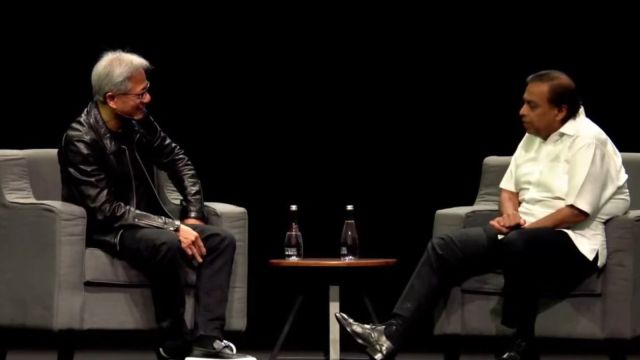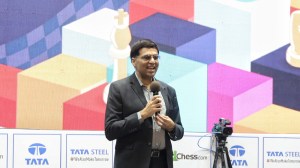NVIDIA tightens grip of India’s AI chip market through deals with Reliance, others
The Reliance-NVIDIA partnership comes at a time when India is looking to position itself as a global leader in semiconductor manufacturing and AI.
 NVIDIA CEO Jensen Huang (left) with Reliance Industries chairman Mukesh Ambani (right). (Screenshot: NVIDIA)
NVIDIA CEO Jensen Huang (left) with Reliance Industries chairman Mukesh Ambani (right). (Screenshot: NVIDIA)NVIDIA reiterated its partnership with Reliance Industries to build state-of-the-art AI infrastructure in India on Thursday, October 24. Speaking at the chip giant’s AI Summit held in Mumbai, NVIDIA CEO Jensen Huang said, “2024 will see 20 times growth in compute capacities in India.”
Huang made these remarks in conversation with Mukesh Ambani, the chairman and managing director of Reliance Industries. “In order to lead in artificial intelligence, you need to have AI model tech and massive quantities of data, which India has,” Huang said.
“When I met PM Modi, he asked me to address his Cabinet on AI. He told me that India should not export data to import intelligence, just as India should not export flour to import bread. We should add value to the data ourselves,” Huang revealed about his interaction with the prime minister last year, adding that NVIDIA’s partnership with Reliance would “start that journey”.
Meanwhile, Ambani underlined Reliance Jio’s infrastructure as crucial to transforming India into a global AI hub. “We have also been fortunate to have strong connectivity infrastructure. Today, apart from the US and China, India has some of the best digital connectivity, including 4G, 5G, and broadband networks. While our company initially did not operate in this domain, we have now become the largest data company in the world,” he said, adding that the telecom major was ready for a “big scale-up” of its data centres at Jamnagar, Gujarat.
Stressing that AI should be affordable and available, the Indian billionaire said that he was counting on NVIDIA so that Jio customers “don’t have to change their phones” to use AI.
Ambani also expressed “deep respect” for Meta CEO Mark Zuckerberg for “bringing open-source to the world of intelligence.” Additionally, he mentioned using NVIDIA’s enterprise and omni-bus AI tools to train “hundreds and thousands of developers” in India.
What is the Reliance-NVIDIA partnership?
NVIDIA announced last month that it would be joining hands with Reliance to develop an indigenous, foundational large language model (LLM) that would be trained on Indian languages and tailored to serve customer needs specific to the country.
The chip manufacturer also said that it would be co-developing AI infrastructure “more powerful than the fastest supercomputer in India” with Reliance.
While the exact terms of the deal are unclear, NVIDIA said that it will give Reliance access to its GH200 Grace Hopper Superchip as well as the company’s AI supercomputing cloud service called DGX Cloud. “The NVIDIA-powered AI infrastructure is the foundation of the new frontier into AI for Reliance Jio Infocomm – Reliance Industries’ telecom arm,” it said in a press release.
What does the tie-up mean for India?
The partnership between the world’s second most valuable AI company and one of India’s largest conglomerates comes amid the country’s aspirations to be a global leader in semiconductor manufacturing and AI by leveraging public-private partnerships.
Combining NVIDIA’s GPU technology with Reliance’s existing infrastructure and market reach could significantly accelerate the deployment of AI applications in the country by startups and other tech service providers.
The telecom major has previously said it will host NVIDIA’s GPUs in its data centres that it hopes to scale up to over 2,000 megawatts (MW) in capacity.
Facing competition from rivals like AMD and Intel, NVIDIA is looking to strengthen its presence in India’s fast-expanding AI chip market by striking deals with other Indian companies as well.
At Tuesday’s event, Huang revealed that Tech Mahindra is developing an AI model in Hindi called Indus 2.0 that will be powered by NVIDIA’s chips and software. IT companies like Infosys and Wipro are also reportedly using NVIDIA’s software to build custom LLMs for their enterprise clients.
Indian startups like Flipkart, Zoho, and CoRover.ai are also looking to roll out Hindi-based LLMs powered by NVIDIA’s technology.
IIIT-Delhi said that it leveraged NVIDIA’s microservices to develop an AI-powered data integration and predictive analytics tool called AMRSense that can detect antibiotic prescription patterns in local languages. “India used to be a country that exported software. In the future, India will be a country that exports AI,” Huang said at the AI Summit.







